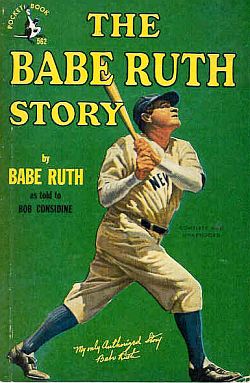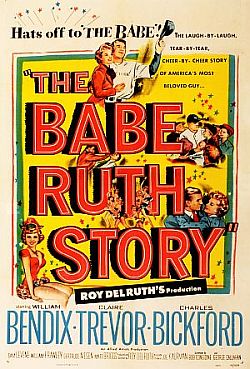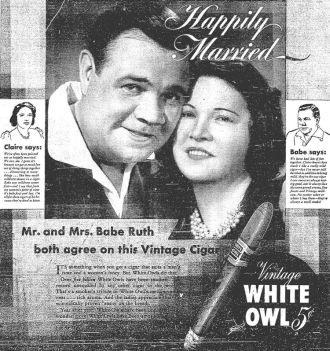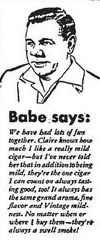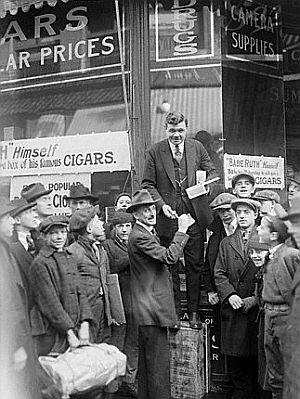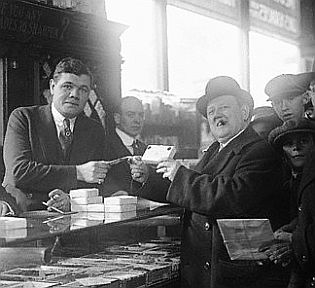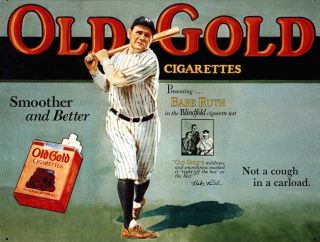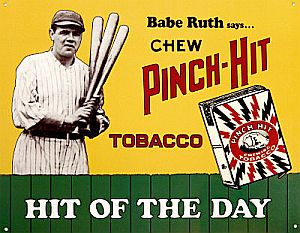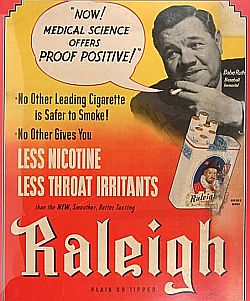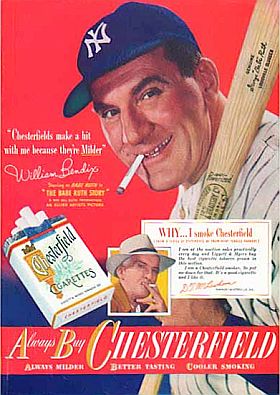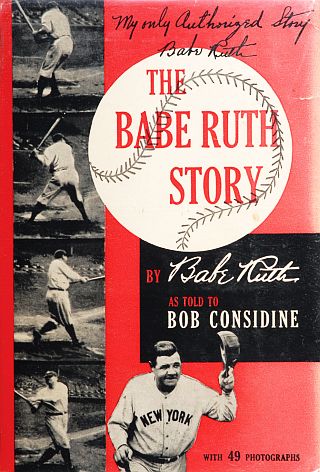
Book cover for 1948 1st edition of “The Babe Ruth Story” as told to Bob Considine, published by E.P. Dutton. Click for book.
In 1947, Ruth had also authorized a biography about his life and times — The Babe Ruth Story (cover at right) — which would be published in 1948. Written in the first person, Ruth’s story was “told to Bob Considine,” then a famous author and Hearst syndicated newspaper columnist. Considine’s name appears on the book’s cover along with Ruth’s — as well as a hand-written note at the top, supposedly from Ruth, calling the book “my only authorized story.”
The Babe Ruth Story, however, was not written by Considine – or at least a good portion of it came from another source. Considine did meet with Ruth several times in attempts to interview him for the book. Another sports writer, Fred Lieb, who worked for the New York Telegram newspaper, became the real ghostwriter for the book. Lieb later recounted his role to other writers, including Lawrence Ritter and Leigh Montville:
“The Babe Ruth book is under Considine’s name, but I gave him most of his information. I dictated that book for about a week before the 1947 World Series. I told everything I knew or could recall about the Babe – well, everything that could be printed, anyway.”
According to Lieb, Considine didn’t know enough about Ruth to do his biography, and hadn’t covered him as extensively as Lieb had. “I was with Ruth [as a sportswriter] from 1920 to 1934. Considine didn’t come to New York until around 1933.”
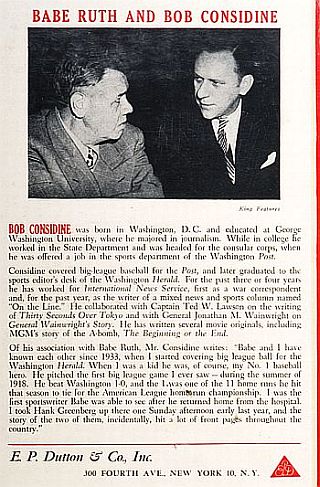
Back cover of 1948 book, “The Babe Ruth Story.”
When the book came out in May 1948, it was Bob Considine’s name on the cover, plus a photo of he and Ruth on the back cover, along with Considine’s biography and considerable author credits.
Considine was born in Washington D.C., grew up there and graduated from George Washington University with a journalism degree. However, he had also worked at the state department while in college, and might have had a career overseas if it weren’t for a Washington Post job offer as a sports writer. He covered the sports beat there and at the Washington Herald between 1930 and 1933. Thereafter, Considine served as a war correspondent for the William Randolph Hearst-owned International News Service (a predecessor of United Press International).
From 1937 to 1975 Considine’s “On The Line” column was syndicated nationally. He also authored some 25 books, including Thirty Seconds Over Tokyo, a 1943 collaboration with Captain Ted Lawson. His “On the Line” column was also the basis for radio commentaries.
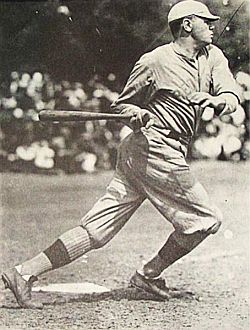
Young Babe Ruth in action with the Boston Red Sox. Click for story with more of his career statistics and the batting records he set.
“Babe and I have known each other since 1933, when I started covering big league ball for the Washington Herald. When I was a kid, he was, of course, my No. 1 baseball hero. He pitched the first big league game I ever saw – during the summer of 1918. He beat Washington [then the Senators] 1-0, and the 1 was one of the 11 home runs he hit that season to tie for the America league homerun championship. I was the first sportswriter Babe was able to see after he returned home from the hospital [during his cancer treatments]. I took Hank Greenberg [famous Detroit Tigers slugger] up there one Sunday afternoon early last year [1947] and the story of the two of them, incidentally, hit a lot of front pages throughout the country.”
The 250-page book on Ruth was published by E.P. Dutton & Co. in New York, in May of 1948. Below are the internal book jacket fly leafs offering the publisher’s description of the book – which Ruth claimed was his only authorized story, a line used on the cover and in marketing.
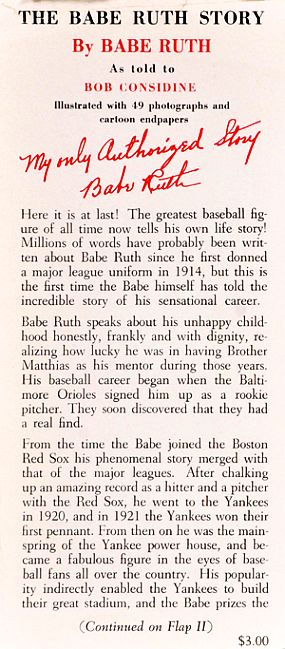 Inside front book flap for “The Babe Ruth Story,” which also repeats “my only authorized story” note. |
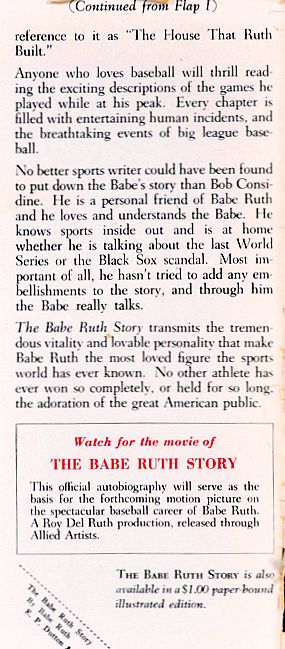 Inside back book flap for “The Babe Ruth Story” also mentioned the forthcoming film & paperback edition. |
In his treatments for cancer, Ruth had received, in different stages, both radiation and some newer drug treatments. During this time, he was in and out of the hospital, a period when he had also lost quite a bit of weight and had difficulty speaking and swallowing.
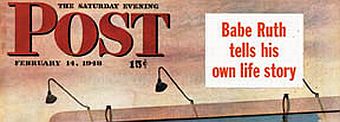
An 8-part series of the Babe Ruth book ran in the Saturday Evening Post. The top of the Feb 14th edition ran a feature box for part 1.
“A lot of publishers were there because it was obvious that Babe’s days were numbered. Bennet Cerf [a founder of Random House] stood in line to get the Babe’s autograph. Ernest Hemingway was there. The books were just about running out, the end of the line near, and I said, ‘Jeez, I’d like to have one, too.’ Babe opened the book and wrote, in his marvelous Spencerian handwriting, ‘To my pal Bob…’ And he looked up and said, ‘What the hell is your last name?’ I’d spent two months with him.”
Excerpts from the Ruth-Considine book appeared in an eight-part series in The Saturday Evening Post, then a popular weekly magazine read by millions. The series appeared under the by-line “Babe Ruth with Bob Considine” and ran under the title: “My Hits – And My Errors.” (sample page below).
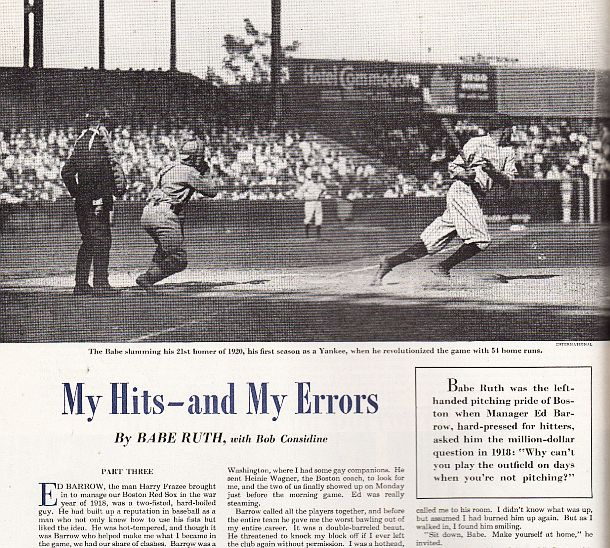
Sample page from the Saturday Evening Post series on “The Babe Ruth Story,” showing a young Ruth sprinting from the batters’ box on the occasion of his 21st Yankee home run in 1920, a year he hit 54 HRs, changing the game thereafter.
The serialization of The Babe Ruth Story in The Saturday Evening Post ran in editions that appeared between February 14th, 1948 and April 3rd, 1948. That exposure no doubt helped bring notice to the book and helped increase its sales. A New York Times book review covering both the Ruth book and another on pitching star Walter Johnson, appeared in May of 1948.
Paperback publishers at the time, also released Babe Ruth books. Bantam had a Babe Ruth book out in 1948, and Pocket Books (then owned by Marshall Field III who also owned the Chicago Sun newspaper) apparently had the rights and/or an agreement with Dutton, to publish The Babe Ruth Story under its name in paperback form. The Pocket Books edition of The Babe Ruth Story shown at right featured Ruth on the cover in his distinctive home-run swing.The Babe Ruth Story was also the first baseball book to crack the New York Times bestsellers list, then in its 13th year. Sales of the book were spurred in part by the Babe’s passing, as the book had only been out a few months before his death. The Babe Ruth Story was on the New York Times bestsellers list for three weeks.
Today, copies of The Babe Ruth Story, especially autographed hardback editions, are highly valued by collectors. A Babe Ruth autographed 1948 hardback edition of The Babe Ruth Story sold for $6,462.50 at Robert Edwards Auctions in 2008 – billed by the auction house as “one of the most desirable of all baseball books.” Ruth-autographed copies of this book are especially rare since he was quite ill at the time and only signed a limited number of copies.
As the Robert Edwards auction house has stated: “Thus, signed copies of this book are not only rare but also represent one of the most important and final items ever penned by the legendary ‘Sultan of Swat.’ For that reason they are highly prized by collectors today.” At least one other copy of a signed hardback edition of The Babe Ruth Story sold at Robert Edwards Actions for $4,740.00 in 2013.

One of the movie posters for 1948 film, “The Babe Ruth Story,” this one also promoting Louisville Slugger bats.
Babe Ruth Film
As the book was being written, plans for a Hollywood film on Ruth using the same title – “The Babe Ruth Story” – were also underway, with the film to be based on the Bob Considine book. Considine, in fact, was hired to help with the screenplay.
Starring in the film would be: William Bendix as Ruth; Claire Trevor as Ruth’s wife, Claire; Charles Bickford as Brother Matthias, and William Frawley (later famous for his I Love Lucy TV role as Fred Mertz) as Jack Dunn, Ruth’s manager during his years with the minor league Baltimore Orioles. The film would be produced by Roy Del Ruth (no relation), who had directed a number of actors in the 1930s, including, James Cagney, Bette Davis, Edward G. Robinson, Ginger Rogers and others. Allied Studios would distribute the film.
The idea for a film on Ruth and his life had been kicking around in Hollywood since 1941 or so. But with the outbreak of WWII, the project was shelved for a time, and then the film was on again – off again while trying to find the right lead actor. But in 1947, with Ruth’s health in decline, it became the intent of Allied Artists studio to quickly produce the film and get it into theaters while Ruth was still alive.
Ruth had been signed by the studio as a consultant to help prepare Bendix for the role, and in late-April-early-May 1948, Ruth and Claire went to Hollywood.
On June 13, 1948, when the New York Yankees celebrated the 25th anniversary of Yankee Stadium, there was a also a ceremony retiring Ruth’s No. 3 jersey. It was the last time Ruth would appear at the stadium. Following that outing, and over the next week or so, Ruth traveled on behalf of an American Legion Baseball project with Ford Motor Co., visiting three cities in the Midwest. Not long thereafter, he was back in the hospital, as by this time the cancer had spread throughout his body.
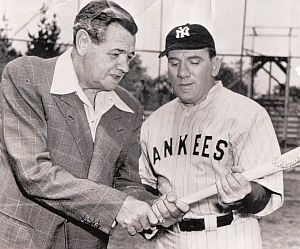
Babe Ruth giving actor William Bendix a few pointers on the art of hitting, May 1948. Ruth was then battling cancer.
As for the film’s reception, Leigh Montville would note in his own book on Ruth, The Big Bam:
“…The movie was so bad, so cliche filled and unbelievable, that people [attending the premiere] said they wished they also could have left [as Ruth did]. ‘The Babe Ruth Story’ was killed across the board by the critics.
“ ‘No home run,’ Wanda Hale of the Daily News said, ‘It’s more than a scratch single, a feeble blooper back of second base.’”
Still, one bad film wasn’t going to tarnish the legend of Babe Ruth, which remains intact today, warts and all. And although the 1992 biopic, The Babe, was made with John Goodman in the lead role, there may yet be room for other films to come on this giant personality and how he changed the game. Certainly in the book department, Ruth is well covered. According to Leigh Montville and others at least 27 books have been written on Ruth, but that mysteries about his life still remain.
For additional stories on Babe Ruth at this website see: “Babe Ruth Days, 1947 & 1948” (covers special days honoring Ruth at Yankee Stadium and reviews his career); “Ruth at Oriole Park” (about a statue of Ruth at Baltimore’s Camden Yards, his early baseball youth, and years in Baltimore); and “Babe Ruth & Tobacco” (Ruth’s endorsements of various cigar, cigarette, and chewing tobacco products, as well as appearances at a tobacco shop in Boston). See also “Baseball Stories,” a topics page at this website with additional baseball history. Thanks for visiting – and if you like what you find here, please make a donation to help support the research and writing at this website.
Thank you. – Jack Doyle
|
Please Support Thank You |
____________________________________
Date Posted: 28 August 2015
Last Update: 7 May 2021
Comments to: jdoyle@pophistorydig.com
Article Citation:
Jack Doyle, “The Babe Ruth Story: Book & Film, 1948,”
PopHistoryDig.com, August 28, 2015.
____________________________________
Sources, Links & Additional Information
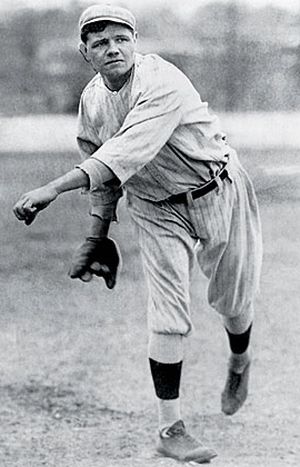 1910s: Young Babe Ruth pitching for the Red Sox. As a pitcher his record was 94-46, with an ERA of 2.88. |
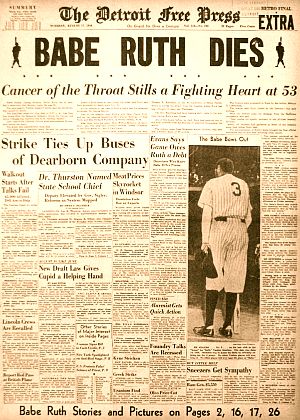 Aug 17th, 1948: When Babe Ruth died, he was treated like a national hero and his passing was front-page news across the country; here with The Detroit Free Press. |
“Babe Ruth Homers Again; Life Film Story $100,000,” New York Times, September 13, 1946.
“Republic Planning Film on Babe Ruth,” New York Times, April 3, 1947.
“Babe Ruth Film Set; Allied Artists to Produce Movie Based on Considine Book,” New York Times, July 18, 1947.
Gladwin Hill, “Bendix Steps Up to the Plate as Babe Ruth,” New York Times, April 4, 1948.
Arthur Daley, “Sports of the Times; The Babe’s Own Story,” New York Times, April 26, 1948.
Rex Lardner, Book Reviews, “For the Baseball Lover’s Library,” New York Times, May 2, 1948.
“People Who Read and Write” (On Dutton Book Party, Ruth Book), New York Times, May 9, 1948.
“‘Babe Ruth’ Premiere Set; Film Story of Famed Bambino Opens at Astor,” New York Times, July 26,” July 8, 1948.
“Ruth Sees Premiere of Film on His Life,” New York Times, July 27, 1948.
“Babe Ruth,” Wikipedia.org.
Robert Creamer, Babe: The Legend Comes to Life, 1976.
“The Babe Ruth Story,” Turner Classic Movies.
“Bob Considine,” Wikipedia.org.
Lawrence Ritter, The Babe: The Game That Ruth Built, 1997.
Leigh Montville, The Big Bam: The Life & Times of Babe Ruth, New York: Doubleday, 2006.
Tom Bartsch, “Baseball’s Best-Sellers: An Updated List of Baseball Books that Landed on the N.Y. Times Best-Seller List,” Sports CollectorsDigest.com, October 8, 2012.
Frank Jackson, “Bombing in the Bronx: The Babe Ruth Story,” HardBallTimes.com, October 28, 2014.
Lot # 1002: “1948 First Edition of The Babe Ruth Story Signed by Babe Ruth” (starting bid – $1,500.00; Sold For – $4,740.00), 2013 Auction, Robert Edward Auctions, LLC, Watchung, NJ,.
“U.S. Mourns For ‘Babe’ Ruth, Baseball Hero,” Gloucester Citizen (England, U.K.), Tuesday 17 August 1948.
“The Babe Ruth Story” (film), Wikipedia.org.
“The Babe Ruth Story,” American Film Institute.
_____________________________
